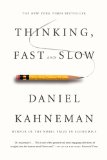Summary | Excerpt | Reviews | Beyond the Book | Readalikes | Genres & Themes | Author Bio

Critics' Opinion:
Readers' Opinion:
First Published:
Oct 2011, 512 pages
Paperback:
Apr 2013, 512 pages
 Book Reviewed by:
Book Reviewed by:
Beverly Melven
Buy This Book
Figure 3
Now that you have measured the lines, you - your System 2, the conscious being you call "I" - have a new belief: you know that the lines are equally long. If asked about their length, you will say what you know. But you still see the bottom line as longer. You have chosen to believe the measurement, but you cannot prevent System 1 from doing its thing; you cannot decide to see the lines as equal, although you know they are. To resist the illusion, there is only one thing you can do: you must learn to mistrust your impressions of the length of lines when fins are attached to them. To implement that rule, you must be able to recognize the illusory pattern and recall what you know about it. If you can do this, you will never again be fooled by the Müller-Lyer illusion. But you will still see one line as longer than the other.
Not all illusions are visual. There are illusions of thought, which we call cognitive illusions. As a graduate student, I attended some courses on the art and science of psychotherapy. During one of these lectures, our teacher imparted a morsel of clinical wisdom. This is what he told us: "You will from time to time meet a patient who shares a disturbing tale of multiple mistakes in his previous treatment. He has been seen by several clinicians, and all failed him. The patient can lucidly describe how his therapists misunderstood him, but he has quickly perceived that you are different. You share the same feeling, are convinced that you understand him, and will be able to help." At this point my teacher raised his voice as he said, "Do not even think of taking on this patient! Throw him out of the office! He is most likely a psychopath and you will not be able to help him."
Many years later I learned that the teacher had warned us against psychopathic charm, and the leading authority in the study of psychopathy confirmed that the teacher's advice was sound. The analogy to the Müller-Lyer illusion is close. What we were being taught was not how to feel about that patient. Our teacher took it for granted that the sympathy we would feel for the patient would not be under our control; it would arise from System 1. Furthermore, we were not being taught to be generally suspicious of our feelings about patients. We were told that a strong attraction to a patient with a repeated history of failed treatment is a danger sign - like the fins on the parallel lines. It is an illusion - a cognitive illusion - and I (System 2) was taught how to recognize it and advised not to believe it or act on it.
The question that is most often asked about cognitive illusions is whether they can be overcome. The message of these examples is not encouraging. Because System 1 operates automatically and cannot be turned off at will, errors of intuitive thought are often difficult to prevent. Biases cannot always be avoided, because System 2 may have no clue to the error. Even when cues to likely errors are available, errors can be prevented only by the enhanced monitoring and effortful activity of System 2. As a way to live your life, however, continuous vigilance is not necessarily good, and it is certainly impractical. Constantly questioning our own thinking would be impossibly tedious, and System 2 is much too slow and inefficient to serve as a substitute for System 1 in making routine decisions. The best we can do is a compromise: learn to recognize situations in which mistakes are likely and try harder to avoid significant mistakes when the stakes are high. The premise of this book is that it is easier to recognize other people's mistakes than our own.
Useful Fictions
You have been invited to think of the two systems as agents within the mind, with their individual personalities, abilities, and limitations. I will often use sentences in which the systems are the subjects, such as, "System 2 calculates products."
Thinking, Fast and Slow Copyright © 2011 by Daniel Kahneman





The House on Biscayne Bay
by Chanel Cleeton
As death stalks a gothic mansion in Miami, the lives of two women intertwine as the past and present collide.

The Flower Sisters
by Michelle Collins Anderson
From the new Fannie Flagg of the Ozarks, a richly-woven story of family, forgiveness, and reinvention.

The Funeral Cryer by Wenyan Lu
Debut novelist Wenyan Lu brings us this witty yet profound story about one woman's midlife reawakening in contemporary rural China.
Your guide toexceptional books
BookBrowse seeks out and recommends the best in contemporary fiction and nonfiction—books that not only engage and entertain but also deepen our understanding of ourselves and the world around us.